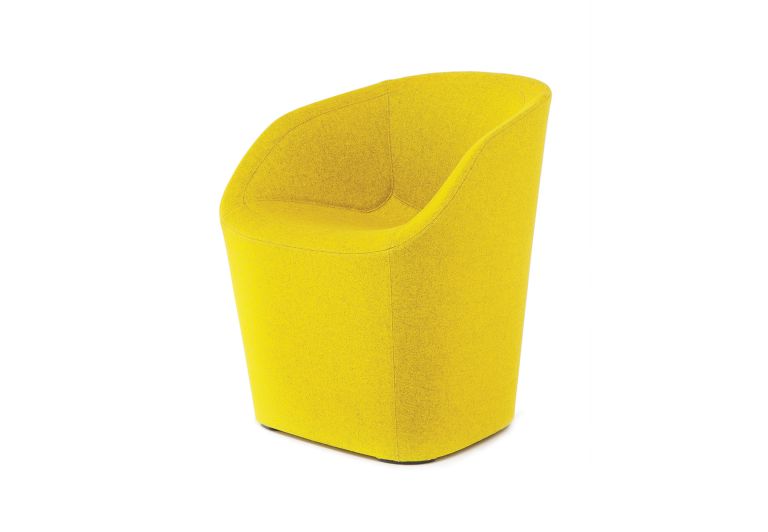A few years ago, FutureSpace Managing Director Angela Ferguson started to panic that the world wouldn’t need physical space anymore. “Technology was becoming so prevalent in everything that we did, I thought we were headed for a world that looked like Blade Runner,” she says.
Not surprisingly, she finds sci-fi films of today – movies that blend the boundaries of humanity and technology – like Her and Ex Machina, fascinating. Perhaps because it’s a theme FutureSpace does all too well with its designs. “But I then realised, the physical space is more important than ever,” Ferguson says. “Even though we’re relying more on technology, the spaces where we meet have much more meaning now and need to be much more carefully designed.”
In just 16 years, FutureSpace has built a reputation on creating cutting-edge environments across childcare, hospitality and retail, but most famously, workplace. Founded by Stephen Minnett in 2001, the studio’s philosophy is centred on creating a vision for the future of our built environments. “It’s about using research about the future and seeing how that will impact the spaces we inhabit and how that in turn impacts peoples behaviours in those spaces,” says Ferguson.
FutureSpace combined forces with Ferguson's Design Studio in 2009, after jointly winning Google’s first ever Australian fitout. Design Director Gavin Harris joined a few months later and the rest, you could say, is history. Each director has a focus for the firm: Steven Minnett, the Founding Director, takes ownership of workplace strategy; Ferguson, client management and business strategy; and Harris, design. “You could say we’re like the three musketeers; we all have different strengths, but we have similar values when it comes to design. None of us are into design just for the sake of it. We all believe people are the product of their environment and we want to create spaces where people can be their best selves,” says Ferguson.
Amidst the activity-based working (ABW) boom, the studio developed a high-end clientele list including Qantas and various financial institutions. Pivotal projects for tech giants Microsoft in 2011 and Jones Lang LaSalle (JLL) in 2012 further cemented FutureSpace’s place as leading designers that can disrupt and transform space. “JLL changed things, in that we designed one of the first ‘true’ agile environments in Australia. It was a very solid, corporate client going agile,” says Harris.
In 2014, the REA Group fitout in Melbourne became another game-changer when FutureSpace helped REA bring its agile development philosophy into the physical environment, followed by PwC, who is creating a client experience unlike any other in Australia. “So much of ‘doing business’ today is about connecting with other people and creating relationships. It’s about cementing these relationships and living up to a reputation. I believe what we’ve been able to achieve with PwC will fundamentally change the way that business looks at collaborating with its clients,” says Ferguson.
With a stack of industry awards under its belt, including Interior Design Excellence Awards (IDEA), Premier’s Design Awards (VIC), Australian Interior Design Awards, Dulux Colour Awards, Design Journey Awards, and Property Council of Australia Awards, the mid-sized firm has come a long way since its humble beginning in a modest office in North Sydney. Now with offices in Sydney and Melbourne, there’s a team of 25 interior and architectural designers that combine forces to solve the future accommodation needs of organisations in an intelligent and inspiring way.
While Harris acknowledges that the complexity of project delivery and documentation has become more involved over the years, he admits that by adopting agile working methods themselves, the company has been able to respond quicker than ever before. “Our designs have always been strategic responders, but we’ve developed a maturity along the way in how we handle the design process. We have learnt to communicate with clients in a language they understand; in a way that demonstrates how they wish to work with their people,” says Harris.
Travel plays a big part in keeping the team inspired but Ferguson admits inspiration comes from all directions. “It’s hard to exactly pin down where I find inspiration, because you never stop being a designer,” says Ferguson. “From how you set the table, to how you put a meal together, design is so much a part of everything I do.”
But one thing the company is certain of, is that Australia leads the way when it comes to workplace design. Do they feel pressure to remain at the forefront of innovative design with a name like ‘FutureSpace’? No. Harris sees it more as an opportunity; a chance to keep changing, developing, moving and ultimately listening to clients and working with them. Ferguson also attributes Australia’s leading advancements in workplace design to the war for talent. “Businesses aren’t just competing against their own sector for top talent anymore. Really smart businesses have come to realise that the workplace can play a huge part in attracting and retaining talented staff.”
And when it comes to their own people, they can spot talent when they see it (Harris senses a ‘buzz’ in the naturally gifted), but it’s perhaps the firm’s commitment to care, learning and nurture that makes FutureSpace fly as a collective. “If someone brings something left of field to the table, you develop it out,” says Harris. “The greatest thing is not to be fearful of someone else’s idea; develop it and nurture it, and that is the strength of the studio.
That’s the exciting part.”
Featured Products

Blom Chair








